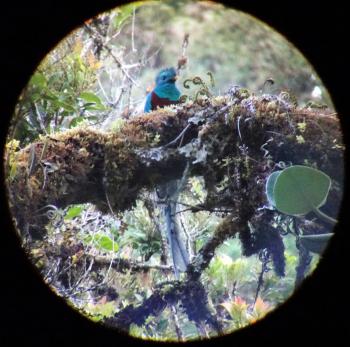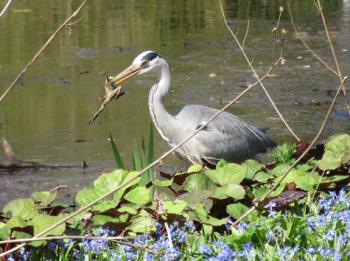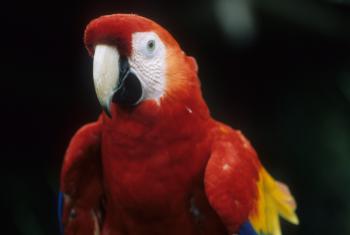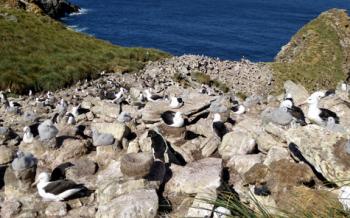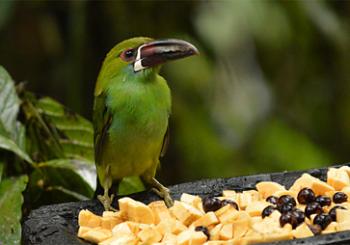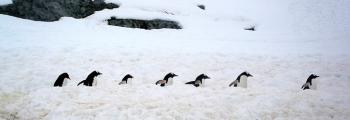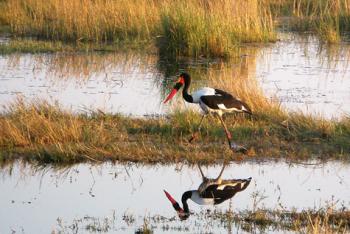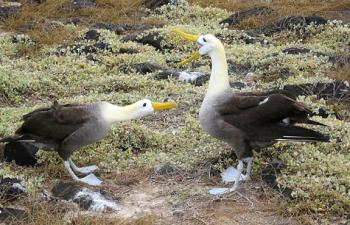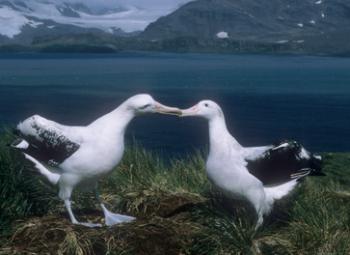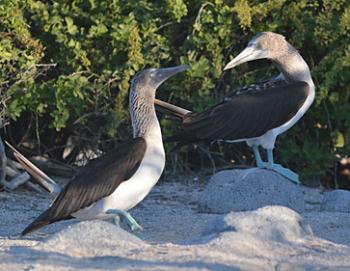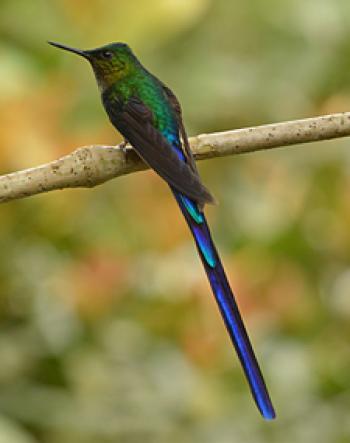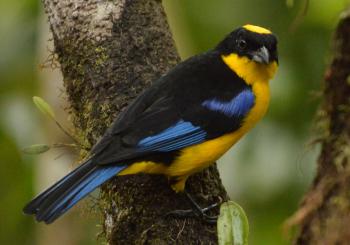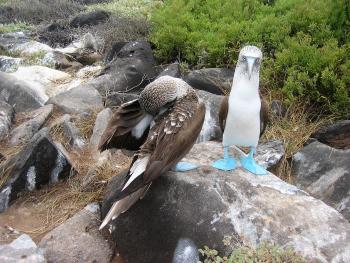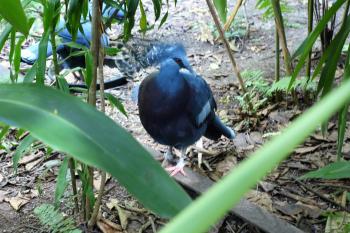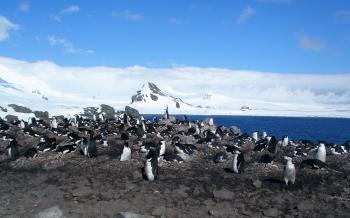A good bird-watching site (6 of 6)
Subscribers were invited to write in about places, outside of the US, where they've had rewarding sightings of birds. (We cannot accept more submissions.)
In addition to the types of birds they saw, we asked travelers to each tell us where they were and the year/month/time their visit took place. We also wanted to know how difficult it was to reach an area, what equipment would be recommended and what the weather was like.
We've printed responses about sites in the Americas, Africa and Australia, and we're wrapping things up this month with various areas. Get your birding on!
When you travel, don't forget to watch birds in cities. You will encounter them in parks and other green areas. Becoming acquainted with the varieties will enrich your travels because you will recognize them again as you continue your explorations.
In April 2015, my husband, Calvin, and I enjoyed a cruise on the waterways of the NETHERLANDS and Belgium, taking the 7-night "Tulip Time" cruise with AmaWaterways (Calabasas, CA; 800/626-0126, www.amawaterways.com). The route included generous amounts of time in larger cities, primarily Amsterdam and Brussels.
Our primary purpose for the trip was not to see birds; it was to enjoy the spring floral displays of the region and see the World War II sites featured on the itinerary. Watching bird activity turned out to be an unexpected highlight in ways we had not anticipated.
We had decided to schedule an extra two days in Amsterdam before the cruise and another three days after. We routinely arrive one day prior to a scheduled itinerary, especially a cruise, to make sure we are at the starting point of the trip at the appointed time, just in case there are any unforeseen travel delays due to weather or mechanical problems. On this trip, however, we had another reason for arriving early: we had never explored Amsterdam's museums and historic sites at leisure.
Calvin suggested that we choose Sandton Hotel de Filosoof, now called Pillows Anna van den Vondel (Anna van den Vondelstraat 6, Amsterdam; phone +31 20 683 30 13, www.pillowshotels.com/amsterdam-vondel), as a base for our explorations.
Not only did the hotel's location allow for easy access on foot to the museums we wanted to visit, but, in the opposite direction, on Overtoom, an artery street, it provided easy access to the city's tram service.
Unbeknownst to us, however, birds were calling. From Anna van den Vondelstraat, we were just steps away from Vondelpark, Amsterdam's largest city park. Literature provided in our hotel room advised that flocks of chartreuse parakeets, with rose-colored rings around their necks, could be seen in the park, thus the first place we went in Amsterdam was to see wild parakeets.
Immediately upon entering the park, we saw, heard and spotted a flock. Noisy and gregarious, these flashy birds caught our interest, and every day we were in Amsterdam, we walked into the park to observe them.
We learned that these rose-ringed parakeets (Psittacula krameri) have been living in Amsterdam since about 1976. Several thousand live in the city today, making their homes in the holes of old trees. While some may view this alien species to be a problem, we were delighted to have the chance to observe them.
(Other European cities report flocks of the same species, although they do not always have the same breeding success as in Amsterdam, where residents feed them.)
On our second trip into Vondelpark, we walked along the many extensive water features. Vantage points in the park provided unusually close and intimate views of various birds, yet we never felt we were disturbing them.
We spotted a grey heron (Ardea cinerea) hunting, catching and eating a frog. We saw grey herons many times in the park because it is a large bird that is easy to see along the edges of the water.
We frequently saw Eurasian coots (Fulica atra) in or near the water as well, and throughout Vondelpark, Eurasian blackbirds (Turdus merula), resembling their New World counterparts, entertained us.
Later, on our cruise, we saw most of the species again (although not the parakeets) and were able to name them.
Returning from the cruise, we reflected upon how much observing these common local birds had added to our trip to the Netherlands and Belgium. Although we had done everything else on the schedule as planned, including museum visits, it was the bird-watching that had slowed us down and most helped us appreciate the new environments we were exploring.
We then realized that these simple experiences observing birds in urban environments had enriched our travels on other trips as well.
For example, in Tallinn, ESTONIA, and St. Petersburg, RUSSIA, in May 2011, we watched Eurasian jackdaws (also known as western jackdaws, or Coloeus monedula) in city parks and found them to be fascinating. While leaving Tallinn, headed east, we saw a white stork (Ciconia ciconia) standing on the ground — not an uncommon bird but memorable to us.
In St. Petersburg, we observed the blue tit (Cyanistes caeruleus) and the Eurasian nuthatch (Sitta europaea) in the wooded areas we walked through at Peterhof.
Our Russian guide, Natalya German-Tsarkova (email natalya.german@tzar-travel.com or visit www.tzar-travel.com), had kindly brought my husband unsalted sunflower seeds as a snack. When the nuthatches and the blue tits appeared to be unafraid of us, I suggested that Calvin put a few seeds in his hand to see if the birds would take them, just as chickadees might do at home. Seeing the colorful birds alight on his hand and each fly off with a sunflower seed is one of our special memories.
For daylight bird-watching in city parks or other urban environments, we carry binoculars and wear comfortable footwear and clothing appropriate to the weather. We do not take scopes nor carry heavy bird books or elaborate telephoto lenses for our camera.
We take photographs and notes about the birds we see and, for later identification, rely on photographs or quick sketches or talk to other birders we meet on site.
When on a cruise, the ship's or riverboat's library may have bird books to consult. Most public libraries in the United States stock books about birds in other areas of the world. The Internet is particularly useful once you have a scientific name for a bird you've seen.
I would be happy to respond to questions via email at charfst@aol.com.
Linda Harfst
Madison, WI
Bird-watching "sites"? I'm no birder and, at 76, have given up carrying a long lens in favor of my iPhone.
But who could forget breakfast in COSTA RICA with scarlet macaws staring from a handrail 3 feet away! And paying $20 for the morning boat ride to see Montezuma oropendolas from afar only to discover them in a tree behind my cabin when I returned!
Frigate birds in flight are the first things visitors see in Ecuador's GALÁPAGOS, and visitors can't wait to see the blue-footed boobies, not realizing that they're also flying all around, just with their feet tucked together. But it's the Galápagos finches flittering all around that thrill!
On safaris in BOTSWANA, you can see gorgeous lilac-breasted rollers, and hornbills the same colors as fall leaves, sitting on branches at eye level.
In PATAGONIA, huge condors circle overhead.
Even I could tell the difference between the mating ritual of the waved albatross in the ANTARCTIC and that of another kind of albatross on a previous trip to the Galápagos Islands.
I have photos of birds — that were practically at my fingertips — taken in India, Egypt, Newfoundland, New Zealand and Zimbabwe. I can't identify many of them, but seeing them so close and easy to photograph left me breathless!
Bird-watching sites? Nah, I wouldn't know where to tell you to go. But you get the picture!
Bobbi Benson
Burlingame, CA
If you want to see different varieties of penguins at one time, you have to go to ANTARCTICA, which usually means taking an expedition cruise. In December 2011, my husband and I went to the Antarctic Peninsula on the Vavilov, a Russian research ship. The cruise was operated by Quark Expeditions, and we made our arrangements through Adventure Life (Missoula, MT; 800/344-6118, www.adventure-life.com).
Crossing the Drake Passage, we saw pelagic birds, including several kinds of albatrosses and giant petrels. Near the peninsula, we saw many chinstrap and gentoo penguins, Antarctic sheathbills, Antarctic cormorants (shags), Antarctic terns and brown skuas as well as Cape and Antarctic petrels.
But there are many kinds of penguins, so in January-February 2017 we returned to the far south on a cruise to the Falklands, South Georgia Island and the Antarctic Peninsula on the Hebridean Sky. This cruise was operated by Polar Latitudes but, again, arranged through Adventure Life.
In the Falklands, we saw nesting black-browed albatrosses mixing with rockhopper penguins. It was entertaining to watch Magellanic penguins wandering among grazing sheep and to see Magellanic and macaroni penguins crossing the beaches. Although we spotted a few king penguins in the Falklands, we found South Georgia Island the best place to see them.
One stop we made there was at a rookery with over 60,000 nesting pairs of king penguins — an amazing sight! On that trip, we also saw Adélie penguins, more chinstrap and gentoo penguins, Magellanic oystercatchers, albatrosses, giant petrels and skuas.
In planning a trip to the Antarctic region, you should take into consideration the timing as well as the locations to see, as penguin behaviors vary with the season.
For example, our first trip to Antarctica was early in the cruise season, so we saw courting, nest building and egg laying.
Our second trip was later in the season, so there were penguin chicks with their distinctive plumage and charming behavior. Some of the chicks were curious about these strange humans and walked right up to look at us. We also got to watch chicks chase their parents around begging for food.
Pauline Ho
Albuquerque, NM
My wife, Carol, and I are not avid birders, but we enjoy watching and photographing birds. We recommend three countries where we thoroughly enjoyed seeing a multitude of species that are uncommon or absent in the US.
We visited Ecuador in spring 2013. All bookings were made through Columbus Travel (Bountiful, UT; 800/373-3328, columbusvacations.com).
We began our adventure with a 7-day cruise on a small, 12-passenger catamaran in the GALÁPAGOS ISLANDS, where we saw many amazing birds. The more famous are the blue-footed and red-footed boobies and the unusual frigate birds that display their red throats for potential mates.
In the Galápagos, there are 177 reported species of birds, including penguins, cormorants and even albatrosses.
After the amazing cruise, we spent a couple of days in the Bellavista Cloud Forest Reserve, a couple of hours northwest of Quito, ECUADOR.
There are reportedly another 1,600 species in Ecuador, most of them in the cloud forest, including the Andean cock-of-the-rock as well as very colorful toucans and tanagers and well over 100 species of hummingbirds.
In the early, barely light hours of the morning, in the mist and rain and down a muddy, slippery path, we saw a few Andean cock-of-the-rock birds. However, none of our pictures were clear in the rain — disappointing, since my wife is a pretty good amateur photographer and has good equipment.
We also went to the high-altitude Cotopaxi National Park, about 48 kilometers south of Quito, and saw the Andean albatross at a far-off distance and, of course, the giant hummingbird.
•
We have visited the Okavango Delta in BOTSWANA three times, most recently in 2014. There are reportedly 490 species of birds there. The best birding is in green season, February-March. At that time, the migrating birds are in their mating plumage.
We booked through Fish Eagle Safaris (Houston, TX; 800/513-5222, www.fisheaglesafaris.com). We saw many species of kingfisher and the famous and common fish eagle plus hawks, hornbills and bee-eaters, like the carmine.
•
In tropical northern Queensland, AUSTRALIA, there are reportedly 677 bird species. We used Del Richards (phone +61 7 4094 1199, www.finefeathertours.com.au) as a guide in September 2016. In addition to other species, we saw parrots, lorikeets, sunbirds, kingfishers, emus and even the famed cassowaries in the wild.
Larry Crabill
Maumelle, AR
After viewing David Attenborough's documentary "Birds of Paradise," I knew that seeing some of the birds of paradise might be difficult. However, I was determined to try in May 2017 while staying at the Ambua Lodge (Tari Gap, Hela Province; phone +675 542 1438) in the Tari Highlands of PAPUA NEW GUINEA.
Rising before sunrise, our group trekked through the cool tropical forest with local guides adept at locating both the ribbon-tailed astrapia and the King of Saxony bird of paradise high in the canopy. Seeing the birds take flight with their long tail feathers undulating was exhilarating.
Other birds we spotted were the short-tailed paradigalla, cassowary and Victoria crowned pigeon. This was part of a small-group trip organized by Trans Niugini Tours (Mount Hagen, Papua New Guinea; phone +675 719 89397, www.pngtours.com) and led by Greg Stathakis.
•
COSTA RICA has the most colorful birds that I have ever seen. My husband, John, and I were fortunate to see the resplendent quetzal, renowned for its brilliant plumage, while staying at the Savegre Lodge (San Gerardo de Dota 11703, San José Province, Costa Rica; phone +506 2740 1028, www.savegre.com) in February of 2017. At an elevation of 7,000 feet, the weather was cool during our visit.
Early one morning, our guide, Hector Calvo, used a spotting scope to help our group see this beautiful bird more clearly as it perched high in the forest canopy. Hector also helped us take photographs through the scope.
With Hector's expertise, we spotted 97 species of birds on this trip, a tour taken with Overseas Adventure Travel (Cambridge, MA; 800/955-1925, oattravel.com). Some of my favorites were the scarlet macaw, violet sabrewing hummingbird, azure-hooded jay, blue-throated toucanet, collared trogon and flame-colored tanager.
Some of those birds were spotted in the Monteverde Cloud Forest, along the Rio Frío or in Manuel Antonio National Park.
•
John and I traveled aboard an expedition ship to Ecuador's GALÁPAGOS ISLANDS in June of 2004, wintertime (cool, comfortable and sunny), specifically to see blue-footed boobies. I was thrilled to see not only blue-footed but red-footed boobies plus frigate birds.
I was totally unprepared for the sheer numbers of birds we saw and how oblivious they were to humans. What was most surprising, though, and memorable, were the albatrosses squawking and performing a courtship dance. What a spectacle that was!
•
A trip aboard the Polar Star to the ANTARCTIC PENINSULA in December of 2011, summer in the Southern Hemisphere, afforded John and me the chance to see chinstrap, gentoo and Adélie penguins as well as south polar skuas, cape petrels, Antarctic terns, kelp gulls and albatrosses.
On our first landing, at Barrientos Island, we viewed both chinstraps, gentoos and giant petrels. On Half Moon Island, we also saw Antarctic (blue-eyed) shags. The Adélies had rookeries on Petermann Island. Being in close proximity to the penguins and observing their playful behavior was delightful. They were easy to photograph, too!
•
In the Okavango Delta in BOTSWANA, whether traveling in a mokoro (canoe), motorboat or jeep, a traveler will see an array of the nearly 500 species of birds to be found.
Witnessing a pack of 60 vultures devour carrion within minutes, seeing saddle-billed storks leisurely wading through the waters of the delta in search of food and watching African fish eagles skimming the sky are some of the fond memories that we have of our safari in July of 2007.
We stayed at DumaTau Camp in Linyati and Xigera Camp in the Okavanga Delta, both operated by Wilderness Safaris (South Africa; phone +27 11 257 5000, www.wilderness-safaris.com), and they provided expert guides to assist my husband and me in locating and viewing the stunning wildlife.
On all of our trips, John and I have discovered that photographing birds is a challenge. Therefore, good binoculars and telephoto lenses (we use a 400mm) are recommended.
Seeing animals in their natural habitats has often been the focus of my travels, thus visiting Costa Rica to view the resplendent quetzal, hiking into the Tari Highlands of Papua New Guinea to spy the King of Saxony bird of paradise, gently trekking trails dotted with blue-footed booby nests in the Galápagos Islands and sitting on the shores of the Antarctic Peninsula to observe penguins swim and traverse penguin highways have been some of my most memorable experiences.
Janet Weigel
San Diego, CA
* Please note this correction in regards to the sighting of an Andean albatross.

